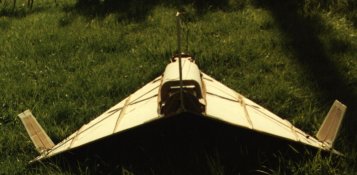

Aspirespace Rocket Engineering Society
Caret Wings
In the 1950's, Terrence Nonweiler produced a design for a delta-winged aircraft with a deeply concave underside known as a 'Caret wing' waverider because from the rear it looks like your keyboard's caret symbol: ^
What he'd succeeded in doing was to create a three-dimensional aircraft underside which behaved physically and mathematically like the flow under a simple two-dimensional wedge (see our 'what is a waverider' page for more on wedge flows). Way back then in the days before computers, this made the maths so much easier.


Every aeromodeller will look at a Caret wing and pronounce it unflyable because of its negative dihedral (known as anhedral). They know that positive dihedral (having the wingtip higher than the wing root) aids stability whereas negative dihedral causes an unstable aircraft.
However, there is a little-known law contrived by one of the fathers of the delta wing: Dietreich Kuchemann, that every five degrees of wing leading-edge sweepback has the same stabilising effect as one degree of dihedral. And so you can balance the anhedral required for the Caret wing with a sufficient amount of sweepback to get a net stabilising effect.
Caret wings are remarkably stable at low speeds, even at the high angles of attack required for landing, because if you think about the geometry, the leading edges of the Caret wing are somewhat like the leading edge slats on conventional aircraft; the airflow sees them as drooped. Caret wings can also exploit ground effect: the incoming airflow gets trapped between the runway and the underside cavity which allows the wings to fly at a lower airspeed. This same trick used on the fast passenger carrying catamarans.
Aspirespace and our friends have had tremendous fun over the years flying Caret-wing models off of kites, cliffs, and piggy-backed off of rockets. Our Caret wing shown above was a basic radio-controlled slope-soaring glider (minus its upper wing skin in these photos) that was steered by all-moving tip-fins. It flew extremely well despite its 73 degrees of leading-edge sweepback.
The Caret wing was the first waverider concept, but now we know that the important features are just the sharp wing edges and some degree of underside concavity around those edges.



